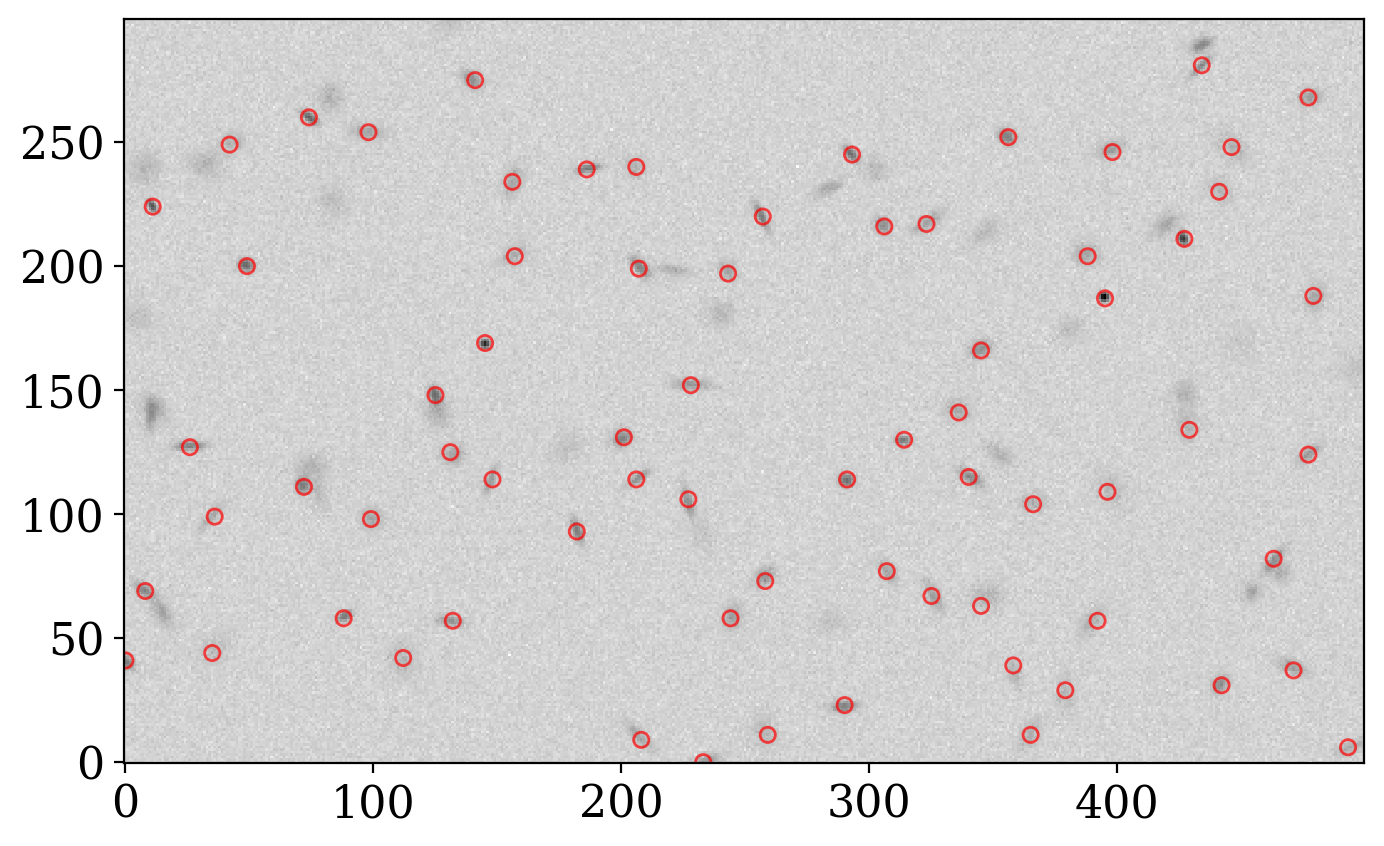8.3.1. Peak finding#
8.3.1.1. Simulated image of galaxies and stars#
In the first part of this notebook we consider an image that includes 100 sources, all with Gaussian profiles, some of which are fairly elongated. We used this image in the previous section about removing the background prior to source detection.
As usual, we begin with some imports.
import warnings
from astropy.stats import sigma_clipped_stats, gaussian_sigma_to_fwhm
from astropy.table import QTable
from astropy.visualization import simple_norm, SqrtStretch
from astropy.visualization.mpl_normalize import ImageNormalize
import matplotlib.pyplot as plt
import numpy as np
from photutils.aperture import CircularAperture, EllipticalAperture
from photutils.centroids import centroid_2dg
from photutils.datasets import make_100gaussians_image, make_gaussian_sources_image
from photutils.detection import find_peaks, DAOStarFinder
plt.style.use('../photutils_notebook_style.mplstyle')
To begin, let’s create the image and subtract the background. Recall that this image contains a mix of star-like object and more extended sources.
data = make_100gaussians_image()
mean, med, std = sigma_clipped_stats(data, sigma=3.0, maxiters=5)
data_subtracted = data - med
8.3.1.2. Source Detection with peak finding#
For more general source detection cases that do not require comparison with models, photutils offers the find_peaks function.
This function simply finds sources by identifying local maxima above a given threshold and separated by a given distance, rather than trying to fit data to a given model. Unlike the previous detection algorithms, find_peaks does not necessarily calculate objects’ centroids. Unless the centroid_func argument is passed a function like photutils.centroids.centroid_2dg that can handle source position centroiding, find_peaks will return just the integer value of the peak pixel for each source.
This algorithm is particularly useful for identifying non-stellar sources or heavily distorted sources in image data.
The centroid-finding, which we do here only so that we can compare positions found by this method to positions found by the star-finding methods, can generate many warnings when an attempt is made to fit a 2D Gaussian to the sources. The warnings are suppressed below to avoid cluttering the output.
Let’s see how it does:
with warnings.catch_warnings(action="ignore"):
sources_findpeaks = find_peaks(data_subtracted,
threshold=5. * std, box_size=29,
centroid_func=centroid_2dg)
print(sources_findpeaks)
id x_peak y_peak peak_value x_centroid y_centroid
--- ------ ------ ------------------ ------------------ -------------------
1 233 0 22.633606464239687 234.32551060610888 0.38896986412871687
2 493 6 13.546963965223004 494.1272167404115 5.939571884949902
3 208 9 17.346874844390104 207.13796151354234 10.355177520263105
4 259 11 11.248467564978402 257.83238483501776 12.22740506322798
5 365 11 12.637249593274138 364.55155912596456 9.224483096533689
6 290 23 28.98909001390059 289.57041897476165 21.47837588946521
7 379 29 10.906120071732058 380.5885171360037 26.49194761963024
8 442 31 27.009595861523184 440.63903769793376 31.37637787846706
9 471 37 18.989486145201486 470.44183656812066 39.73450647456632
10 358 39 13.519122776424464 358.35138033049554 34.727672725854575
... ... ... ... ... ...
62 293 245 38.69510036786478 295.1028939224394 241.8094512143153
63 398 246 18.775975076986878 396.5029989021236 248.07414278626956
64 446 248 13.906635070560856 446.7652008958186 247.68076682470934
65 42 249 13.256323329550764 35.157240743452434 243.32985878928932
66 356 252 30.00969198273592 355.1722928770967 252.69137480544242
67 98 254 15.847143478097742 98.71781235685901 253.1060400794161
68 74 260 47.35429493883031 77.76082097397119 262.46985847821963
69 477 268 17.870494505057362 479.22594977370267 267.4704052654612
70 141 275 23.127844438211586 138.14700328179325 275.01535057159293
71 434 281 28.311057338166965 434.1035119677329 286.0635169424726
Length = 71 rows
# Set up the figure with subplots
fig, ax1 = plt.subplots(1, 1, figsize=(8, 8))
norm = ImageNormalize(stretch=SqrtStretch())
fitsplot = ax1.imshow(data, cmap='Greys', origin='lower', norm=norm,
interpolation='nearest')
ax1.scatter(sources_findpeaks['x_peak'], sources_findpeaks['y_peak'], s=30, marker='o',
lw=1, alpha=0.7, facecolor='None', edgecolor='r');

8.3.1.3. Comparing Detection Methods#
Let’s compare how peak finding compares to using DAOStarFinder on this image.
detect_fwhm = 5.0
daofind = DAOStarFinder(fwhm=detect_fwhm, threshold=5.*std)
sources_dao = daofind(data_subtracted)
print(f'''DAOStarFinder: {len(sources_dao)} sources
find_peaks: {len(sources_findpeaks)} sources''')
DAOStarFinder: 48 sources
find_peaks: 71 sources
Let’s plot both sets of sources on the original image.
fig, ax1 = plt.subplots(1, 1, figsize=(8, 8))
# Plot the data
fitsplot = ax1.imshow(data, norm=norm, cmap='Greys', origin='lower')
marker_size = 60
ax1.scatter(sources_findpeaks['x_peak'], sources_findpeaks['y_peak'], s=marker_size, marker='s',
lw=1, alpha=1, facecolor='None', edgecolor='r', label='Found by find_peaks')
ax1.scatter(sources_dao['xcentroid'], sources_dao['ycentroid'], s=2 * marker_size, marker='D',
lw=1, alpha=1, facecolor='None', edgecolor='#0077BB', label='Found by DAOfind')
# Add legend
ax1.legend(ncol=2, loc='lower center', bbox_to_anchor=(0.5, -0.35))
ax1.set_xlabel('X (pixels)')
ax1.set_ylabel('Y (pixels)')
ax1.set_title('Sources Found by Different Methods');

That peak findging works better on this image that DAOfind shouldn’t be surprising because many of the sources are not round. As we discussed in the section on source detection in a simulated image, the star-finding techniques are not a good match for an image like this with many extended sources.
8.3.1.4. Summary#
There are several more sources found by find_peaks than are found found by the star-finding algorithms, but several are still being missed. In the section on image segmentation with a simulated image we will look at a much different approach that is especially well suited to finding extended objects.

